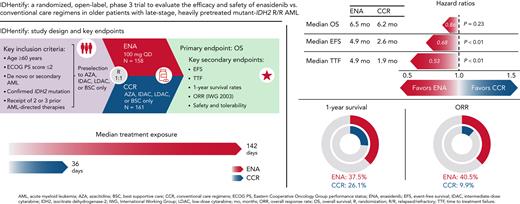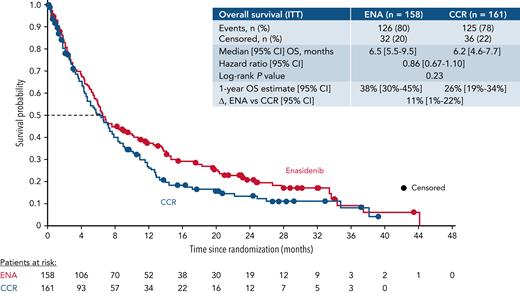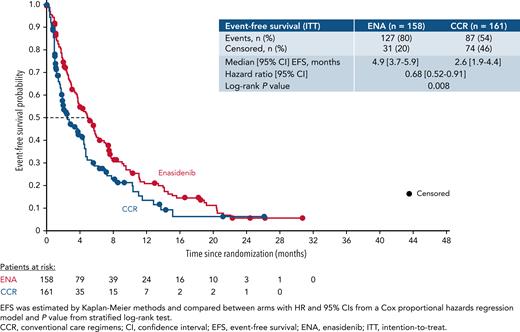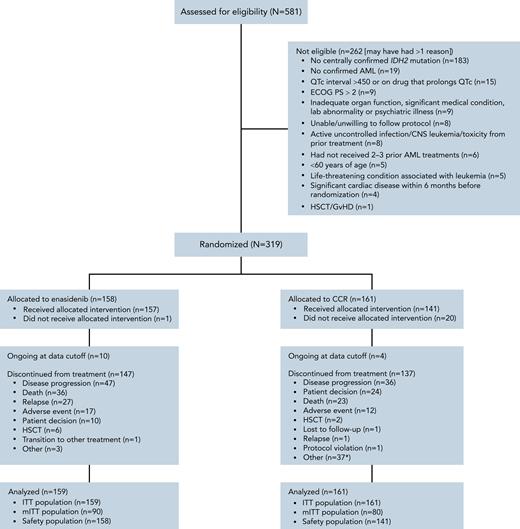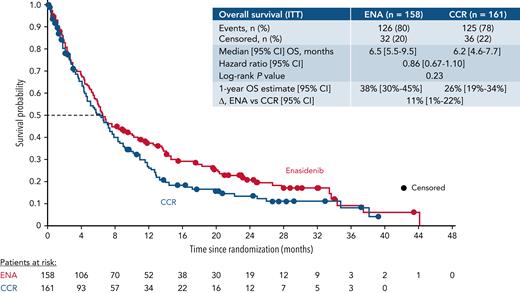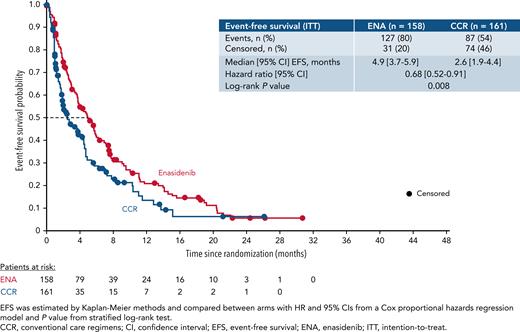Key Points
EFS was meaningfully improved with enasidenib vs CCR; OS was confounded by early dropout and use of subsequent AML therapies.
Enasidenib provided meaningful morphologic and hematologic responses vs CCR in this heavily pretreated older R/R mutant-IDH2 AML population.
Abstract
This open-label, randomized, phase 3 trial (NCT02577406) compared enasidenib, an oral IDH2 (isocitrate dehydrogenase 2) inhibitor, with conventional care regimens (CCRs) in patients aged ≥60 years with late-stage, mutant-IDH2 acute myeloid leukemia (AML) relapsed/refractory (R/R) to 2 or 3 prior AML-directed therapies. Patients were first preselected to a CCR (azacitidine, intermediate-dose cytarabine, low-dose cytarabine, or supportive care) and then randomized (1:1) to enasidenib 100 mg per day or CCR. The primary endpoint was overall survival (OS). Secondary endpoints included event-free survival (EFS), time to treatment failure (TTF), overall response rate (ORR), hematologic improvement (HI), and transfusion independence (TI). Overall, 319 patients were randomized to enasidenib (n = 158) or CCR (n = 161). The median age was 71 years, median (range) enasidenib exposure was 142 days (3 to 1270), and CCR was 36 days (1 to 1166). One enasidenib (0.6%) and 20 CCR (12%) patients received no randomized treatment, and 30% and 43%, respectively, received subsequent AML-directed therapies during follow-up. The median OS with enasidenib vs CCR was 6.5 vs 6.2 months (HR [hazard ratio], 0.86; P = .23); 1-year survival was 37.5% vs 26.1%. Enasidenib meaningfully improved EFS (median, 4.9 vs 2.6 months with CCR; HR, 0.68; P = .008), TTF (median, 4.9 vs 1.9 months; HR, 0.53; P < .001), ORR (40.5% vs 9.9%; P <.001), HI (42.4% vs 11.2%), and red blood cell (RBC)-TI (31.7% vs 9.3%). Enasidenib safety was consistent with prior reports. The primary study endpoint was not met, but OS was confounded by early dropout and subsequent AML-directed therapies. Enasidenib provided meaningful benefits in EFS, TTF, ORR, HI, and RBC-TI in this heavily pretreated older mutant-IDH2 R/R AML population.
Introduction
Acute myeloid leukemia (AML) is a heterogeneous hematologic malignancy that occurs primarily in older individuals.1 Approximately 40% to 60% of older patients with newly diagnosed AML will attain morphologic remission after induction with intensive chemotherapy (IC), leaving a substantial proportion of patients with refractory disease,2 and most patients who attain remission eventually experience relapse.2,3 Prognosis is dismal for patients with relapsed or refractory (R/R) AML,4,5 and treatment outcomes are substantially diminished with each subsequent AML salvage therapy. In a retrospective analysis of 826 patients with AML treated with a variety of AML therapies, the remission rate was 68% in the front-line setting, 42% at first salvage, and 27% at second or later salvage, and median overall survival (OS) was 15.4, 8.7, and 4.8 months, respectively.6 Traditional treatment options for R/R AML include intensive salvage chemotherapy, lower-intensity approaches such as intermediate- or low-dose cytarabine, azacitidine and decitabine, and supportive care measures (eg, blood product transfusions). More recently, advances in the understanding of the molecular landscape in AML have led to the development of targeted therapies for patients with specific gene mutations or markers, and several of these therapies have gained regulatory approval for treatment of R/R AML.7-11
Somatic IDH2 (isocitrate dehydrogenase-2) mutations are noted in approximately 8% to 20% of patients with AML12,13 and have been implicated in the genesis and evolution of AML.14,15 Functional wild-type IDH2 enzymes play a central role in the citric acid cycle, catalyzing the conversion of isocitrate to α-KG (α-ketoglutarate), a key effector of cellular function and epigenetic regulation.16-18 Mutant-IDH2 proteins have neo-enzymatic activity, leading to the production and accumulation of 2-HG (2-hydroxyglutarate), an oncometabolite that blocks α-KG–dependent epigenetic regulators, resulting in hypermethylation of histones and DNA, thereby arresting hematopoietic differentiation.17,19
Enasidenib is an oral, selective, small molecule that inhibits the mutant IDH2 enzyme from catalyzing the production of 2-HG and promotes differentiation of leukemic myeloblasts. Enasidenib was approved in the United States in August 2017 for the treatment of adult patients with mutant-IDH2 R/R AML,13 based on results from a pivotal, single-arm, phase 1/2 study in patients aged ≥18 years with hematologic malignancies harboring an IDH2 gene mutation. Among 214 patients in that trial with mutant-IDH2 AML who were R/R to any prior AML therapy, the overall response rate (ORR) was 38.8%, complete remission (CR) rate was 19.6%, median OS was 8.8 months, and among 157 patients who were red blood cell (RBC)- and/or platelet transfusion-dependent at baseline, 53 (34%) became independent of RBC and platelet transfusions.8 Based on the results from that single-arm trial, we conducted a randomized phase 3 trial to evaluate the efficacy and safety of enasidenib vs conventional care regimens (CCRs) in older patients with late-stage, heavily pretreated mutant-IDH2 R/R AML.
Methods
Study design and participants
This was an international, multicenter, randomized, open-label, phase 3 trial (AG221-AML-004; ClinicalTrials.gov Identifier: NCT02577406). The study was approved by relevant institutional review boards or independent ethics committees at each participating site and was conducted in accordance with the Declaration of Helsinki. All patients provided written informed consent before enrollment. The authors of this report had access to all study data.
The study enrolled patients aged ≥60 years with de novo or secondary AML (World Health Organization classification20), a confirmed IDH2 gene mutation, and an Eastern Cooperative Oncology Group performance status score ≤2. At screening, patients were to have received 2 or 3 prior AML-directed therapies; prior hypomethylating agent (HMA) therapy for higher-risk myelodysplastic syndromes (MDS) also constituted an eligible prior therapy if the patient experienced progression to AML during or within 60 days after receiving the HMA. Bone marrow (BM) samples and peripheral blood smears were collected at screening for central, retrospective review by personnel blinded to study treatment to confirm AML disease status and cytogenetics. IDH2 mutational status at screening was assessed locally and confirmed centrally using the Abbott RealTime IDH2 polymerase chain reaction (PCR)-based assay (Abbott Laboratories; Abbott Park, IL).
Eligible patients were preselected by the study investigator to 1 of 4 CCR treatment options: azacitidine, intermediate-dose cytarabine (IDAC), low-dose cytarabine (LDAC), or best supportive care (BSC) only. Patients were then randomized 1:1 to enasidenib or CCR; patients randomized to CCR received their preselected CCR option. Randomization was stratified (yes vs no) by prior receipt of IC, primary refractory status (ie, no prior attainment of morphologic CR, CR with incomplete hematologic recovery [CRi], or CR with incomplete platelet recovery [CRp]), and prior receipt of allogeneic hematopoietic stem cell transplant (HSCT). Randomization was implemented by an interactive voice response system.
After randomization, patients were to receive their allocated treatment in repeated 28-day treatment cycles: enasidenib 100 mg per day orally (continuous); subcutaneous (SC) azacitidine 75 mg/m2 per day for 7 days per cycle; LDAC 20 mg twice-daily SC for 10 days per cycle; IDAC 0.5 to 1.5 g/m2 per day intravenous (IV) for 3 to 6 days per cycle; or BSC only. All patients could receive BSC as needed according to local practice, including (but not limited to) erythropoiesis-stimulating agents, myeloid growth factors, antibiotics, antifungals, and RBC and platelet transfusions. Hydroxyurea was allowed (except within 72 hours of azacitidine administration) for treatment of leukocytosis, and corticosteroids were allowed for treatment of differentiation syndrome (DS). Patients were to continue receiving treatment until disease progression, relapse after CR/CRi/CRp, unacceptable toxicity, loss to follow-up, withdrawal of consent, or eligibility for alternative therapies such as HSCT. No treatment crossover, including among CCR options, was allowed in the study. The investigators and participants in this open-label trial were not blinded to treatment assignment. The sponsor was aware of treatment assignments but was blinded to summary level information until after the primary analysis database lock.
Endpoints
The primary endpoint was OS, the time from randomization until death from any cause. Secondary efficacy endpoints included investigator-assessed event-free survival (EFS); time to treatment failure (TTF); ORR; time to and duration of response; safety and tolerability; and rates of CR, composite remission (CR+CRi+CRp), sponsor-derived CR plus CR with partial hematologic recovery (CR+CRh), 30- and 60-day mortality, 1-year survival, hematologic improvement (HI, as defined in the International Working Group [IWG] 2006 MDS response criteria21), and HSCT.
Patients were followed for OS from randomization until death, loss to follow-up, withdrawal of consent, or study termination, whichever occurred first; patients who were alive or whose death status was unknown at data cutoff were censored at the last date the patient was known to be alive. EFS was the time from randomization to disease progression (defined per the IWG 2003 response criteria for AML22), relapse after CR/CRi/CRp or death, and TTF was the time from randomization until discontinuation of assigned study treatment for any reason. ORR was the proportion of patients who achieved CR, CRi, CRp, partial remission (PR), or morphologic leukemia-free state, per modified IWG 2003 AML response criteria.22 BM aspirates were collected for assessment of disease status and clinical response on day 1 of cycles 2 and 3, every-other cycle starting at cycle 5, at the end-of-treatment visit, and as clinically indicated. Morphologic responses and EFS were assessed by treating investigators. The CR+CRh rate was derived by the sponsor based on laboratory data for each patient. Rate of HI of the erythroid, neutrophil, or platelet lineages and RBC and platelet transfusion independence (TI) lasting ≥56 days in patients transfusion-dependent at baseline were assessed according to IWG 2006 MDS response criteria.21 Exploratory subgroup analyses were conducted to compare 1-year survival rates between enasidenib and CCR in patient subgroups defined by relevant baseline characteristics.
Exploratory endpoints included changes from baseline in 2-HG concentrations and IDH2 variant allele frequencies (VAFs) and associations between 2-HG, IDH2 VAF, and baseline comutations and clinical response category (CR, incomplete response [IR; CRi/CRp, PR, morphologic leukemia-free state], or no response [NR]). Quantification of total 2-HG in peripheral blood was performed by liquid chromatography–tandem mass spectrometry (Covance, Inc; Princeton, NJ), and IDH2 VAF was quantified in DNA from BM mononuclear cells by digital PCR (Sysmex; Baltimore, MD). Gene mutations cooccurring with IDH2 at screening were assessed by targeted next-generation sequencing using the 37-gene Archer VariantPlex Core Myeloid panel (ArcherDx; Boulder, CO) at a ≥1% positivity threshold.
Safety was assessed by treatment-emergent adverse events (TEAEs) that began or worsened from the first dose through 28 days after the last dose (or from randomization until discontinuation for patients in the BSC-only arm). Exposure-adjusted event rates (EAERs) per 100 patient-years of study drug exposure were calculated as 100∗(n/total patient-years [TPY]), in which n is the total number of events in the treatment arm and TPY is the total patient-years of drug exposure in that arm. TEAEs were coded using the Medical Dictionary for Regulatory Activities (MedDRA) version 22.0 and graded based on National Cancer Institute Common Terminology Criteria for Adverse Events version 4.03.
Statistical analyses
Baseline characteristics are summarized descriptively. Safety was assessed in the enasidenib, azacitidine, LDAC, and IDAC arms for patients who received ≥1 dose of assigned treatment and in the BSC-only arm for patients who had ≥1 postbaseline safety assessment. Efficacy endpoints were assessed in the intention-to-treat (ITT) population, which included all randomized patients regardless of the actual treatment received. OS was also assessed in the prospectively defined modified ITT (mITT) population, which included patients who had an independent confirmation of AML diagnosis, had no eligibility criteria protocol violations, received ≥1 dose of study drug, and underwent ≥1 postrandomization efficacy assessment. Assuming a median OS of 8.0 months in the enasidenib arm and 5.6 months in the combined CCR arm (a 43% improvement with enasidenib vs CCR), the trial prospectively planned to enroll 316 patients (158 per arm) and required 250 deaths to achieve 80% power to detect a constant hazard ratio (HR) of 0.70 and demonstrate a statistically significant difference in OS between arms at a type-I error rate of 0.05 (2-sided).
OS, EFS, and TTF were estimated using Kaplan-Meier methods and compared between arms (enasidenib vs CCR) using HRs from Cox proportional hazards regression models and P values from stratified log-rank tests. Endpoints were tested sequentially, starting with the primary endpoint of OS; secondary endpoints were statistically relevant only if the primary endpoint was significant in favor of enasidenib (otherwise, P values are provided for context only). Rates of investigator-assessed morphologic response and HI were compared by the Cochrane-Mantel-Haenszel test. Rates of CR+CRh were compared using Fisher’s exact test. All statistical tests were 2-sided at a significance level of 0.05. The first patient enrolled in December 2015, and the data cutoff date was March 17, 2020.
The sponsor was involved in study design, data collection, and data analysis. All authors had access to all study data. The lead author had final responsibility for the decision to submit the manuscript for publication. Trial oversight was provided by an independent data monitoring committee.
Results
Study population
Overall, 319 patients were enrolled and randomized to enasidenib (n = 158) or CCR (n = 161) (Figure 1). Patients randomized to CCR were assigned to their preselected treatment: azacitidine, n = 69 (43%); LDAC, n = 37 (23%); IDAC, n = 33 (20%); BSC only, n = 22 (14%) (supplemental Figure 1). Twenty CCR-randomized patients (12%) and 1 enasidenib-randomized patient discontinued before receiving any study drug; 11 CCR-randomized patients had been allocated to receive azacitidine, 5 to IDAC, and 4 to LDAC. Additionally, early treatment discontinuation was more common in the CCR arm: 37% of patients received <2 cycles of their assigned treatment, compared with 11% of patients in the enasidenib arm. Ten patients (6%) in the enasidenib arm and 4 patients (2%) in the CCR arm were still receiving their allocated treatment at the data cutoff. The most common reasons for treatment discontinuation in the enasidenib arm were disease progression, death, and relapse, and in the CCR arm were “other,” disease progression, and patient decision (Figure 1). Of the 37 patients in the CCR arm who discontinued for “other” reasons, 34 were cited as receiving “No benefit from study treatment.” After discontinuing the study drug, 47 patients (30%) in the enasidenib arm and 69 (43%) in the CCR arm received subsequent AML-directed treatments during OS follow-up, including commercially available enasidenib for 19 CCR-randomized patients (12%). The mITT population comprised 170 patients, including 90 patients (57%) in the enasidenib arm and 80 patients (50%) in the CCR arm (azacitidine, n = 32; IDAC, n = 18; LDAC, n = 17; BSC only, n = 13). Reasons for exclusion from the mITT analysis are shown in supplemental Table 1.
CONSORT (Consolidated Standards of Reporting Trials) diagram. CCR, conventional care regimen; CNS, central nervous system; ECOG PS, Eastern Cooperative Oncology Group performance status; GvHD, graft-versus-host disease; HSCT, hematopoietic stem cell transplant; ITT, intention-to-treat; mITT, modified ITT; QTc, corrected QT interval. ∗The most common “other” reason for treatment discontinuation was “No benefit of treatment” (n=34).
CONSORT (Consolidated Standards of Reporting Trials) diagram. CCR, conventional care regimen; CNS, central nervous system; ECOG PS, Eastern Cooperative Oncology Group performance status; GvHD, graft-versus-host disease; HSCT, hematopoietic stem cell transplant; ITT, intention-to-treat; mITT, modified ITT; QTc, corrected QT interval. ∗The most common “other” reason for treatment discontinuation was “No benefit of treatment” (n=34).
The median age at baseline was 71 years (range, 60 to 86), 72% of patients had an IDH2-R140 mutation, and 63% had ELN (European LeukemiaNet)-defined adverse-risk AML (Table 1). Among 249 patients (78%) with available genomic data at baseline, the genes most commonly comutated along with IDH2 were RUNX1 (54%), SRSF2 (45%), DNMT3A (43%), and ASXL1 (37%). Most patients (246 of 319 [77%]) had received 2 prior AML-directed therapies, including 73% (234 of 319) who had received IC and 33 patients (10%) who had received prior HSCT; 40% of patients had primary refractory AML, 11% had experienced 2 prior AML relapses, and 11% had a first AML remission duration of ≤1 year. Baseline demographic and disease characteristics were generally balanced between treatment arms. Patient characteristics in the mITT population were generally similar to those of the ITT population (supplemental Table 2).
Efficacy outcomes
OS was not significantly different between the enasidenib and CCR arms (HR, 0.86; 95% confidence interval [CI], 0.67-1.10; P = .23) (Table 2). Median OS was 6.5 months in the enasidenib arm and 6.2 months in the CCR arm, and estimated 1-year survival rates were 38% vs 26%, respectively (Δ+11%; 95% CI, 1-22%) (Figure 2). One-year survival rates generally favored enasidenib over CCR in subgroups defined by baseline characteristics and prior AML treatment history (supplemental Figure 2), with greatest between-group differences observed in the IDH2-R172 (Δ+31.7%; 95% CI, 11.1-52.3%) and poor-risk cytogenetics (Δ+29.8%; 95% CI, 5.1-54.6%) subgroups. In the mITT population, median OS was 6.9 months vs 5.4 months in the enasidenib and CCR arms, respectively (HR, 0.70; 95% CI, 0.50-0.98; P = .03) (supplemental Figure 3).
Median EFS (ITT population) was 4.9 months in the enasidenib arm, compared with 2.6 months in the CCR arm (HR, 0.68; 95% CI, 0.52-0.91; P = .008) (Figure 3), and median TTF was 4.9 vs 1.9 months, respectively (HR, 0.53; 95% CI, 0.41-0.67; P < .0001) (Table 2). Early mortality rates were similar between the enasidenib and CCR arms: 6.3% and 8.1%, respectively, at 30 days, and 17.1% and 18.6% at 60 days.
ORR was substantially higher in the enasidenib arm than in the CCR arm, 40.5% vs 9.9%, respectively (odds ratio [OR], 6.1; 95% CI, 3.3-11.1; P < .001), as were the CR rate (23.4% vs 3.7%; P < .001), composite remission rate (CR+CRi+CRp) (29.7% vs 6.2%; P < .001), and rate of sponsor-derived CR+CRh (25.3% vs 5.0%; P < .001) (Table 3). Eleven patients in the enasidenib arm (7.0%) and 6 patients in the CCR arm (3.7%) proceeded to HSCT after discontinuing study drug.
The rate of HI in the erythroid, neutrophil, and/or platelet lineages was also higher with enasidenib vs CCR: 42.4% vs 11.2%, respectively (P < .001) (Table 3). Among patients who were transfusion-dependent at baseline, 33 of 104 (31.7%) in the enasidenib arm achieved RBC-TI for ≥56 days, compared with 9 of 97 (9.3%) in the CCR arm. Similarly, more patients in the enasidenib arm attained platelet-TI: 26 of 88 (29.5%) vs 8 of 74 (10.8%) in the CCR arm.
Survival and response outcomes generally favored enasidenib vs each individual regimen within CCR preselection subgroups (supplemental Table 3), but the small sample sizes precluded meaningful statistical comparisons.
Pharmacodynamics
Median baseline 2-HG concentrations were similar between treatment arms (supplemental Figure 4A). 2-HG was substantially reduced during enasidenib treatment, with a greater median maximal 2-HG reduction from baseline with enasidenib than CCR (−97% vs −12%; P < .0001) (supplemental Figure 4B). 2-HG reductions with enasidenib were independent of clinical response, with median reductions of ≥90% from baseline for patients who achieved CR (−100%; n = 31), IR (−99.5%; n = 27), or NR (−95.1%; n = 74) (supplemental Figure 5). In the CCR arm, 2-HG reductions were correlated with clinical response, with median maximal reductions of −64.4%, −74.8%, and −5.4% in the CR, IR, and NR groups, respectively (CR vs NR; P = .003; IR vs NR; P = .001).
Median baseline IDH2 VAF was similar between the enasidenib (34.6%) and CCR (32.7%) arms. During treatment, median IDH2 VAFs were relatively unchanged from baseline, with median maximal reductions from baseline of −6% in the enasidenib group and −4% in the CCR group. Change in IDH2 VAF from baseline was correlated with clinical response in both treatment arms (supplemental Figure 6). In the enasidenib arm, the median maximal VAF reduction from baseline was significantly greater in patients who achieved CR (−74%) than those who achieved IR (−9%; P = .012) or NR (+3%; P < .0001).
All of the 249 patients with next-generation sequencing data available at baseline exhibited ≥1 cooccurring gene mutation in addition to IDH2, and 30 individual mutations were present in ≥5 patients. Within the enasidenib arm, patients in the CR, IR, and NR response groups had a similar median number of comutated genes at baseline (4 [95% CI, 3-4], 4 [95% CI, 3-6], and 5 [95% CI, 4-5], respectively).
Safety
The safety-evaluable population comprised 157 patients (99.4%) in the enasidenib arm and 141 patients (87.6%) in the CCR arm. Median treatment durations were 142 days (range, 3 to 1270) in the enasidenib arm and 36 days (range, 1 to 1166) in the combined CCR arm, and total patient-years of exposure were 101.0 and 47.6, respectively. Only 24% of patients in the CCR arm initiated ≥6 treatment cycles, compared with 50% of enasidenib-randomized patients. On-study, 121 patients (77%) in the enasidenib arm and 86 patients (61%) in the combined CCR arm experienced a treatment-related TEAE. Common enasidenib-related TEAEs were nausea, increased blood bilirubin, and thrombocytopenia (Table 4). Treatment-related grade ≥3 TEAEs were reported in 74 (47%) and 49 (35%) patients in the enasidenib and CCR arms, respectively, with generally similar rates for individual events when accounting for treatment exposure in each arm (supplemental Table 4). Increased blood bilirubin was the only treatment-related grade ≥3 event with a >10-point higher EAER in the enasidenib arm than the CCR arm (EAER, 12.9 vs 0 and 13 vs 0 events, respectively). Serious treatment-related TEAEs were reported with similar frequency in the enasidenib (22%) and CCR (21%) arms; the most common serious events were febrile neutropenia in 2% of enasidenib-treated patients and 8% of patients in the CCR arm, and DS in 6% of enasidenib-treated patients.
Treatment-related TEAEs required enasidenib interruptions for 46 patients (29%), most commonly due to DS (n = 14) and increased blood bilirubin (n = 10). Enasidenib dose was reduced prospectively (to 50 mg per day) due to treatment-related TEAEs for 18 patients (11%), with increased blood bilirubin (n = 5), thrombocytopenia (n = 3), and neutropenia (n = 2) requiring dose-reduction for >1 patient. Five patients (3%) discontinued enasidenib due to treatment-related TEAEs (hemorrhagic diarrhea, hemorrhagic enterocolitis, blast-cell count increased, DS with concurrent hyponatremia, and respiratory failure). In all, 77 patients (49%) in the enasidenib arm and 33 (23%) in the CCR arm died while on treatment, most commonly due to disease progression. Grade 5 TEAEs were suspected to be related to the study drug for 1 patient in the enasidenib arm (hepatic failure during cycle 2) and 5 patients in the CCR arm (acute myocardial infarction [during follow-up], cerebral hemorrhage [on day 14], febrile neutropenia [on day 37], pneumonia [on day 13], and sepsis [on day 5]).
DS occurred during enasidenib treatment for 22 patients (14%), with a median time to onset of 22 days; DS severity was grade 3 in 6 patients (4%) and grade 4 in 2 patients (1%). Enasidenib was interrupted for 14 (9%) of these patients, and 1 patient required treatment discontinuation due to DS concurrent with grade 3 hyponatremia. Seventeen patients received systemic corticosteroids for DS for a median of 4 days, and the median time to resolution of DS was 17 days.
When applying the broad-scope standardized MedDRA query of “Biliary-system–related investigations, signs, and symptoms,” enasidenib-related bilirubin elevations were reported in 40 patients (25%), including 17 (11%) who had grade 3 events (no grade 4 event was reported). The onset of these events occurred within the first 2 months of treatment for most patients, and the median time to resolution was approximately 2 weeks. Bilirubin increases led to enasidenib interruption for 13 patients and dose-reduction for 2 patients but did not require permanent treatment discontinuation.
Discussion
The patient population in this study (aged ≥60 with late-stage R/R AML to multiple prior AML treatments) is especially difficult to treat, with few remaining therapeutic options. While prolonging survival is the main goal of salvage therapy, improvements in morphologic response, functional neutrophil recovery, and reduced transfusion burden are also meaningful outcomes for these patients. The primary endpoint of this phase 3 study in older patients with late-stage mutant-IDH2 R/R AML was not met, with no significant difference in median OS between enasidenib and CCR in the ITT population. Notably, the OS curves show greater separation in favor of enasidenib at later time points (ie, after the median OS); the proportion of patients alive at 1 year was >10% higher in the enasidenib arm than in the CCR arm.
This was an open-label trial, and a substantial number of patients randomized to the “control” arm (ie, CCR) discontinued before receiving any assigned treatment or undergoing a formal study assessment, confounding interpretation of trial outcomes. The open-label study design, while necessary due to the variety of CCR options in the control arm, may have influenced some patients to forego treatment once randomized to CCR. Moreover, enasidenib became commercially available in the United States in 2017, while this study was underway, and a substantial proportion of patients in the CCR arm (12%) received enasidenib as subsequent therapy during OS follow-up, confounding the evaluation of relative treatment effects on OS. Median OS was prolonged with enasidenib vs CCR within the mITT population, which (among other criteria) excluded patients who did not receive any assigned study drug or who had no postrandomization efficacy evaluation.
In the ITT population, enasidenib improved the key secondary endpoint of EFS compared with CCR. In the current AML treatment era with increasingly available therapeutic options, EFS may serve as a better indicator of the efficacy of a specific treatment (ie, its ability to induce and then sustain morphologic response and potentially prolong survival) as it is not confounded by the use of subsequent AML-directed therapies.2 The median TTF was also longer for patients receiving enasidenib than those receiving CCR but may have been influenced by factors unrelated to clinical outcomes in this open-label trial, such as physician preference or patient choice of therapy.
Enasidenib was associated with a meaningful improvement in morphologic responses compared with CCR, including a higher CR rate. Similar to HMAs, enasidenib produces a response pattern different from that of cytotoxic agents23 and, while substantially more frequent, clinical responses to enasidenib manifested more gradually than did responses to CCR, supporting the rationale to continue therapy in the setting of stable disease in the absence of (or before) formal morphologic response. Most CR/CRi responses in this trial occurred at treatment cycle 5 and beyond, which is reflected in the later separation of the OS curves. The composite HI rate was also substantially greater with enasidenib vs CCR; while HI and TI are not IWG-defined endpoints in AML trials,22 they have been shown to be positively associated with better OS and health-related quality of life in patients with AML.24-26 Combination therapy with enasidenib plus injectable azacitidine was recently shown to significantly improve ORR vs azacitidine alone in patients with newly diagnosed mutant-IDH2 AML.27 Combination therapy with an HMA plus venetoclax has shown efficacy in patients with mutant-IDH R/R AML28; whether combining enasidenib with other lower-intensity oral therapies such as oral azacitidine or venetoclax may further improve clinical outcomes for patients with IDH2-mutated AML in the R/R setting remains to be determined.
Enasidenib was associated with marked reductions from baseline in 2-HG concentrations regardless of clinical response (CR, IR, or NR), consistent with robust on-target activity. Reductions in IDH2 VAF in the study appeared to be correlated with clinical response in both arms, with greater reductions in enasidenib-treated patients who achieved CR than those who achieved IR or NR.
The safety of enasidenib 100 mg per day in this trial was consistent with what was reported in the pivotal phase 1/2 study.8 The most common treatment-related events with enasidenib included low-grade gastrointestinal events (nausea and vomiting), cytopenias (thrombocytopenia and neutropenia), hyperbilirubinemia, and DS. Grade ≥3 treatment-related thrombocytopenia and neutropenia were reported with similar frequency between treatment arms, but when accounting for differences in treatment exposure on-study, these event rates were substantially higher in the CCR arm. The rate of enasidenib-associated DS in this study (14%) was also comparable to that reported in the phase 1/2 study in patients with hematologic malignancies (∼12%29), although higher rates of DS with enasidenib have been reported.30 DS events were primarily managed with corticosteroids and required enasidenib discontinuation for only 1 patient. Treatment-related bilirubin elevations are relatively common during enasidenib therapy8 and are primarily attributable to off-target inhibition of the UGT1A1 enzyme responsible for bilirubin metabolism.31
Results from this randomized, phase 3 study support enasidenib as an appropriate oral outpatient treatment for patients with mutant-IDH2 R/R AML. Although enasidenib did not significantly improve OS vs conventional salvage therapies in the ITT population, the risk/benefit profile of enasidenib remains positive, especially considering the clinical benefits in terms of improved 1-year survival rate, EFS, morphologic CR and ORR, and reduced RBC and platelet transfusion requirements compared with CCR, along with an acceptable safety profile.
Acknowledgments
The authors thank Brian Kaiser of Excerpta Medica and Sheila Truten of Medical Communication Company, Inc., funded by Bristol Myers Squibb, for editorial support on an early draft.
This work was supported by Celgene, a Bristol-Myers Squibb Company.
BMS policy on data sharing may be found at https://www.bms.com/researchers-and-partners/independent-research/data-sharing-request-process.html.
Authorship
Contribution: The sponsors collected and analyzed data in conjunction with all authors. S.dB. and C.D.D. wrote the first draft of the manuscript; the data were reviewed and verified by S.dB., C.D.D., P.M.-R., E.L., X.Y., and M.H.; and all authors revised the manuscript and reviewed and approved the final version.
Conflict-of-interest disclosure: S.dB. reports grants and personal fees from Agios and Forma; personal fees from AbbVie, Astellas, Celgene, Daiichi Sankyo, Jazz Pharmaceuticals, Novartis, and Pfizer, outside the submitted work. P.M. reports grants, personal fees, and other from BMS, outside the submitted work. A.C.S. reports other from BMS/Celgene, during the conduct of the study; personal fees and other from AbbVie, Amgen, Astellas, BMS/Celgene, Novartis, and Pfizer; other from Glycomimetics and Servier; and personal fees from Jazz Pharmaceuticals and Teva, outside the submitted work. C.P. reports other from AbbVie, Amgen, Astellas, Janssen, Novartis, and Pfizer, outside the submitted work. A.H.W. reports grants and personal fees from AbbVie, Amgen, AstraZeneca, BMS/Celgene, Novartis, and Servier; grants from F. Hoffmann-La Roche; personal fees from Astellas, Genentech, Janssen, Macrogenics, and Pfizer; and other from Walter and Eliza Hall Institute, outside the submitted work. H.O. reports grants from Jazz Pharmaceuticals Denmark Aps; other from AbbVie A/S and Pfizer Aps, outside the submitted work. H.-J.K. reports personal fees and other from AbbVie, AIMS Bioscience, Amgen, AML-Hub, Astellas, BMS/Celgene, Daiichi Sankyo, Handok, Janssen, LG Chem, Novartis, Pfizer, Sanofi Genzyme, SL VaxiGen, and VigenCell; grants from BL&H; other from Boryung Pharma Co. and Pintherapeutics, outside the submitted work. R.A.L. reports personal fees and other from Celgene, during the conduct of the study. J.K. reports personal fees from AbbVie, Alexion, Amgen, Apellis, Celgene, Jazz Pharmaceuticals, and Novartis, outside the submitted work. F.T. reports other from AbbVie, Novartis, Pfizer, and Takeda; grants, research support, and other from BMS/Celgene; member of an advisory board for AbbVie, Astellas, BMS/Celgene, Novartis, Jazz Pharmaceuticals, and Pfizer, outside the submitted work. J.B. reports personal fees from Ariad/Incyte, BMS, Novartis, and Pfizer, outside the submitted work. O.S. reports personal fees from AbbVie, Celgene/BMS, Jazz Pharmaceuticals, Novartis, and Pfizer, outside the submitted work. H.D. reports grants and personal fees from AbbVie, Agios, Amgen, Astellas, BMS, Celgene, Jazz Pharmaceuticals, Novartis; personal fees from Astex Pharmaceuticals, AstraZeneca, Berlin-Chemie, GEMoaB, Gilead, Helsinn, Janssen, Oxford Biomedica, Roche, and Syndax; grants from Pfizer, outside the submitted work. A.T.F. reports grants and personal fees from AbbVie, Agios/Servier, and Celgene/BMS, during the conduct of the study; personal fees from Amgen, Amphivena, Astellas, Blueprint, Boston Biomedical, Daiichi Sankyo, Foghorn, Forma, Forty Seven, Genentech, Jazz Pharmaceuticals, Kite, Kura Oncology, Ipsen, Morphosys, NewLink Genetics, Novartis, Pfizer, PTC Therapeutics, Seattle Genetics, Takeda, Trillium, and Trovagene, outside the submitted work. E.L., X.Y., M.H., and P.M.-R. report employment and have equity interest in BMS. C.D.D. reports grants and personal fees from AbbVie, Agios, Celgene/BMS, Immune-Onc, Daiichi Sankyo, and Novartis; personal fees from Aprea, Foghorn, GSK, Notable Labs, and Takeda; grants from Calithera, outside the submitted work. The remaining authors declare no competing financial interests.
Correspondence: Stéphane de Botton, Hematologie Clinique, Gustave Roussy, 114 Rue Edouard Vaillant, 94805 Villejuif, France; e-mail: stephane.debotton@gustaveroussy.fr.
References
Author notes
The online version of this article contains a data supplement.
There is a Blood Commentary on this article in this issue.
The publication costs of this article were defrayed in part by page charge payment. Therefore, and solely to indicate this fact, this article is hereby marked “advertisement” in accordance with 18 USC section 1734.

